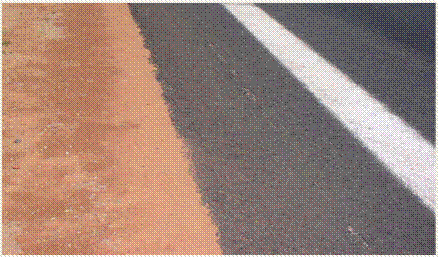In terms of paving operations, there is little difference between the placement and construction of AC and PCC materials (refer to Figure 1) with and without the inclusion of the Safety EdgeSM. However, there are important considerations that should be accounted for when incorporating the Safety EdgeSM into a paving operation. This section of the Guide highlights the general design and construction details when constructing a Safety EdgeSM in conjunction with AC or PCC pavements.
2.1 Safety EdgeSM Use
The Safety EdgeSM provides two important safety related functions. It serves as a mitigating measure to help with pavement edge drop off that occurs after an AC layer is placed, but before shoulders can be reconstructed flush with the paved surface. The Safety EdgeSM also serves as a long-term safety feature for areas susceptible to material displacement and/or erosion adjacent to the paved surface.
An additional benefit of the Safety EdgeSM is that the density of the AC mat adjacent to the pavement edge was found to be higher in most areas with the Safety EdgeSM in comparison to areas without the Safety EdgeSM. The Safety EdgeSM is believed to serve as a restriction to the lateral movement of the AC mat along an unconfined edge. This observation was found from multiple demonstration projects. Visual assessment of many Safety EdgeSM treatments have shown that trucks loaded with asphalt do not deform/damage the finished edge.
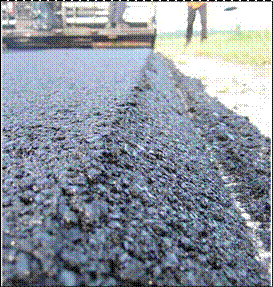 (a) AC Project. |
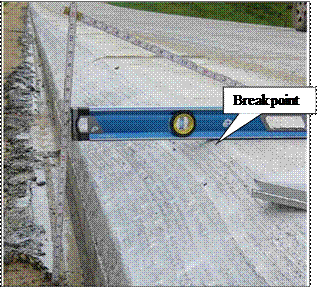 (b) PCC Project |
Figure 1. Safety EdgeSM placed on an AC and PCC project.
Where the Safety EdgeSM Can Be Placed
The Safety EdgeSM can be used in almost every situation to provide a condition towards preventing near vertical lane-shoulder drop offs during construction and over time. It also provides added insurance until such time that maintenance personnel are able to repair eroded areas of the shoulder adjacent to the paved surface.
Where the Safety EdgeSM Should Not Be Placed
A site condition where the Safety EdgeSM should not be used is where the foreslope/embankment or ground surface has a steeper slope than the slope of the Safety EdgeSM. This condition may exist for a portion of the road being paved, thus the Safety EdgeSM should be considered for use on the remainder of the road. Figure 2 depicts this condition.
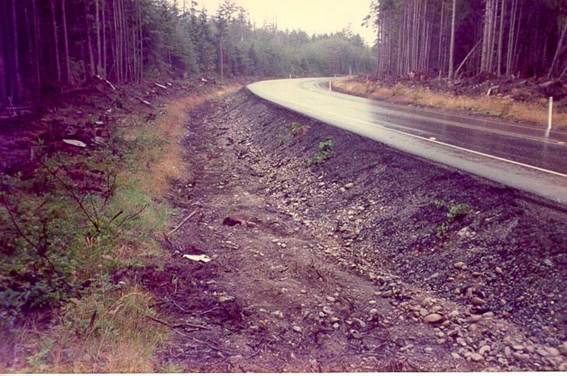
2.2 Pre-Construction and Discontinuous Paving Operations
The pre-construction activities for Safety EdgeSM projects are to review the paving plan and make sure the Safety EdgeSM can be placed in suitable areas along the project. If there are areas with restrictions along the edge of the pavement (for example, guardrails, intersections, and bridges), the width of the roadway and width of paving should be considered so that there is sufficient room for the Safety EdgeSM device for resurfacing projects. As an example, narrow bridges along some low volume roadways can result in conditions where the AC paver screed extensions cannot be moved-in sufficiently when using Safety EdgeSM devices that are bolted to the paver screed, so the paver operator must steer the paver more towards the center of the roadway during paving operations (center line crown or other cross slope changes need to be considered in these conditions). Other areas where the foreslope is steeper than the Safety EdgeSM slope should be noted. These conditions should be discussed in the contractors quality control plan and/or pre-paving meeting and how the condition will be resolved.
Paving across intersections and driveways with the Safety EdgeSM device in place is generally no different than when paving without the Safety EdgeSM. The differences for both AC and PCC paving are noted below. All of these conditions or paving anomalies should be identified and addressed prior to beginning paving operations.
- For AC paving, extra attention from the paver and screed operators may be necessary to accommodate the Safety EdgeSM at transitions for intersections, driveways, and changes in longitudinal elevations or profile. The reason for this extra attention is discussed in Section 3 of the Guide. Specifically, Section 3.2 discusses the different Safety EdgeSM devices and their attachment to the paver. For devices attached to the screed, the screed operator can keep the Safety EdgeSM device lowered or can raise the device above the bottom of the screed so that the Safety EdgeSM is not placed through some intersections (refer to Figure 3). The capability for lowering and raising the device allows the paving operation to continue without disruption when discontinuous features or adjacent features are encountered. For devices attached to the end plate, the screed operator needs to monitor the height of the end plate ski to ensure the desired shape is placed.
- For PCC slip-form paving, the PCC material at the intersection or driveway will need to be sawcut to remove the Safety EdgeSM (refer to Figure 4) or build up the Safety EdgeSM by hand in order to tie into pavement intersections.
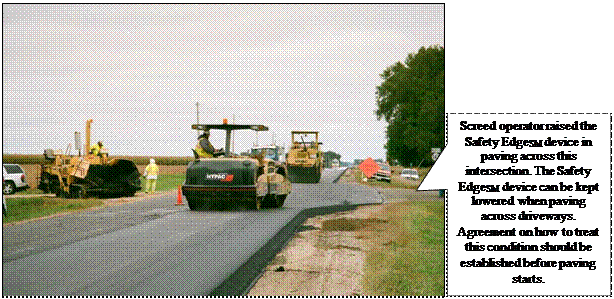
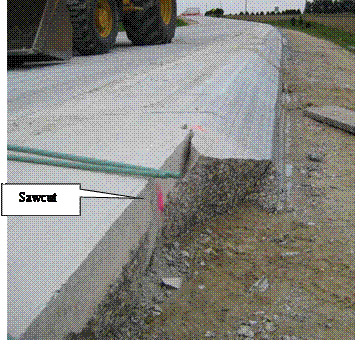
2.3 Pavement Edge/Shoulder Preparation
The pavement edge should be prepared in accordance with standard agency paving operations for both AC and PCC surfaces (refer to Figure 5).

The following items are highlighted to ensure the agency considers them as they have been shown to adversely impact Safety EdgeSM construction on some projects.
- If vegetation exists along the pavement edge consideration should be given to removing this vegetation in the area supporting the Safety EdgeSM prior to paving. Good asphalt paving practice includes not paving on vegetation as the asphalt will not adequately compact and thus will not perform adequately. Figure 6 shows an example of a Safety EdgeSM edge placed over vegetation. For asphalt paving, a clean/clearly visible pavement edge will help the screed operator monitor the material placement along the pavement's edge.
- If the agency removes vegetation/soil from the edge of the pavement (edge clipping), ensure a reasonable grade elevation and slope of the pavement edge/shoulder is established to minimize use of excess pavement material along the edge.
- Edge clipping should extend far enough to accommodate the additional width of the Safety EdgeSM which may be a change in standard operating practice. The wedge part of the Safety EdgeSM is typically additional width, therefore paving a vertical edge depth of 3 inches will require clipping an additional 6 inches of width to accommodate the Safety EdgeSM.
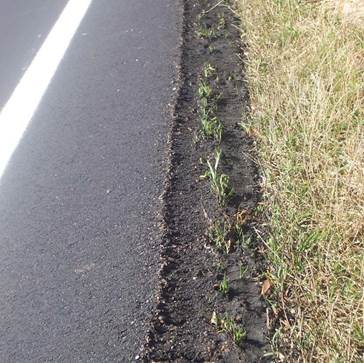
2.4 Slope Measurement
Including the Safety EdgeSM on a new construction or resurfacing project does not impact the agency's material and construction specifications. The only difference in determining the quality between projects with and without the Safety EdgeSM is the measurement of slope for the as-built Safety EdgeSM itself. This part of the Guide discusses measuring the slope of the Safety EdgeSM.
Figure 7 illustrates how the slope is measured or determined for an AC resurfacing project. The length of line B is determined as the distance of a vertical virtual line from the edge or toe of the Safety EdgeSM to the pavement surface cross slope extended. The toe of the Safety EdgeSM can be defined as where a straight line along the surface of the Safety EdgeSM contacts the ground surface. This point becomes important for asphalt mixtures with larger nominal maximum sized aggregate where the removal of one coarse aggregate particle can significantly change the measured slope. The length of line A is determined as the distance from the point where there is space between the straight edge placed on the pavement surface at the edge, defined as the break point, and the vertical virtual line through the toe of the Safety EdgeSM or vertical line B. The angle, Ø, is calculated as Ø = arctan B/A. This angle measurement is the angle that the vehicle tire encounters when the vehicle is attempting to return to the pavement. The slope of a PCC Safety EdgeSM is determined in the same manner. The angle measurement is made on the sloped portion of the Safety EdgeSM and does not include the vertical portion of the PCC edge.
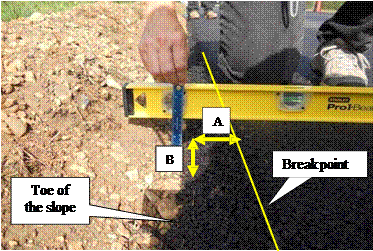
2.5 Backing Material Placement
It should be remembered that the Safety EdgeSM is a mitigation of the drop off created by the AC or PCC overlay or new paved layer; it is not intended to substitute for a shoulder that is flush with the paved surface. After the paved layer or overlay has been placed, the shoulder or backing material needs to be graded back flush with the paved surface. The shoulder material should be placed in accordance with standard equipment and procedures specified by the owner agency for both AC and PCC pavements. The only cautionary note is to grade the backing or shoulder material over and along the Safety EdgeSM as soon as possible but, in the case of an AC pavement, after the mat has cooled sufficiently so that any scuffing or tearing of the surface from construction equipment is minimized. Similarly, PCC should be allowed to cure and gain sufficient strength so that the construction equipment grading the backing material does not damage the PCC Safety EdgeSM. After construction is completed, the Safety EdgeSM will be covered with the backing material and not seen by the road user as shown in Figure 8.
